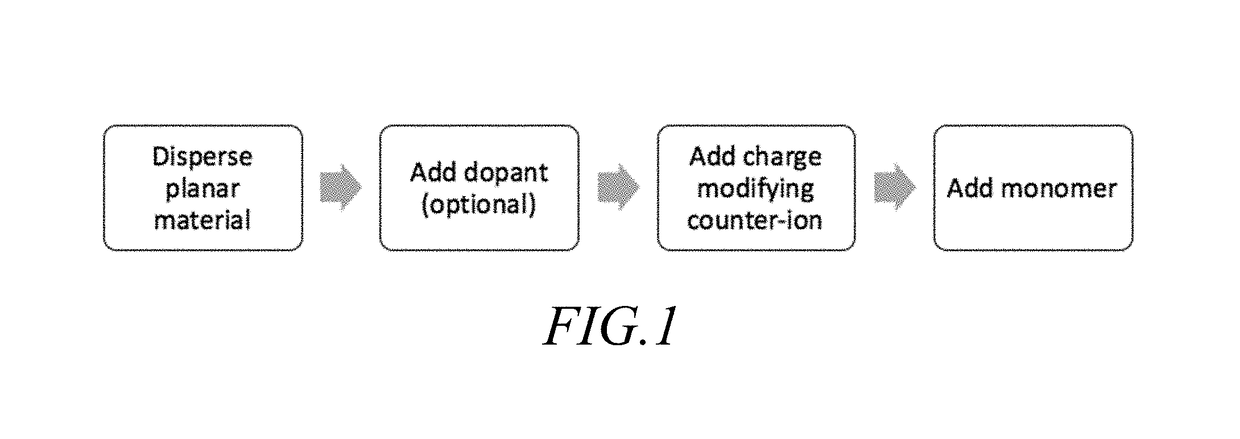Conductive polymer-matrix compositions and uses thereof
a technology of conductive polymer and matrix, applied in the field of rubber compositions, can solve the problems of lack of desirable mechanical improvements, health hazards, manufacturing dangers, etc., and achieve the effect of increasing mechanical strength
- Summary
- Abstract
- Description
- Claims
- Application Information
AI Technical Summary
Benefits of technology
Problems solved by technology
Method used
Image
Examples
example 1
Preparation of Polymer / Laponite Particle Composite
[0315]A polymer-laponite composite was synthesized by mixing laponite, 3,4-ethylenedioxythiophene, FeCl3, polyvinyl alcohol, poly(sodium 4-styrenesulfonate), sodium dodecyl sulfate and water to create a reaction solution. Laponite was first dissolved in water and allowed to disperse for at least 24 hours. The final product was observed using TEM imaging (FIGS. 2, 3A-B). Other components were added sequentially in the order and at concentrations according to Table 2A below.
[0316]
TABLE 2AReaction components for synthesis of composite particlesReaction 1Reaction 2ConcentrationConcentration(wt %)(wt %)Composite CompositionComposite L-18Composite L-19Water98.598.5Laponite RDS0.30.3FeCl30.20.2polyvinyl alcohol0.03—sodium dodecyl sulfate0.30.3poly(sodium 4-0.50.5styrenesulfonate)3,4-ethylenedioxythiophene0.20.2
[0317]Upon addition of all components, the reaction was allowed to stir for 24-48 hours. The polymerization was assessed as complete...
example 2
Characterization Polymer / Laponite Composite
[0322]Composite L-18 was evaluated using transmission electron microscopy (FIG. 3A). A bimodal distribution of particle size was observed, with the two distributions centered at approximate diameters of 100 nm and 2 μm. As observed by osmium-tetroxide stain, the conductive polymer (i.e., poly(3,4-ethylenedioxythiophene)) forms an inter-connected network that spans the surface of the clay particle (FIG. 3B). Laponite particles are disk shaped and randomly oriented and evenly distributed throughout the material, which indicates excellent dispersion of the reaction mixture. The representative composite had the following composition shown in Table 3 below:
[0323]
TABLE 3Representative composite from Reaction 1Concentration %Components of Composite L-18 (w / w)Laponite19FeCl315polyvinyl alcohol2sodium dodecyl sulfate19poly(sodium 4-styrenesulfonate)32poly(3,4-ethylenedioxythiophene)13
[0324]The composite was then diluted with a carrier fluid and depo...
example 3
Synthesis Polypyrrole / Silica Composite Particles
[0326]Conductive polypyrrole-silica composites particles were synthesized by mixing silica and pyrrole monomer in water to create a reaction solution. After allowing 30 minutes for mixing, the oxidizing agent (FeCl3) was added to the reaction solution to initiate polymerization. The final mixture was allowed to stir for approximately 24 hours at temperatures ranging from 0° C. to 22° C. and deemed to be complete by the appearance of a drastic color change of solution. The amounts of the reaction components for 6 representative polymer-silica composite particles (S-1 to S-6) are shown in Table 4, below.
[0327]
TABLE 4Reaction components for 6 representative polypyrrole-silica composite particlesWaterSilicaMonomerOxidantComposite(% wt)(% wt)(% wt)(% wt)S-199.10.30.40.2S-291.82.63.52.1S-399.20.30.30.2S-499.40.30.20.1S-599.50.30.10.1S-698.80.60.40.2
[0328]The resultant polypyrrole-silica composite particles were centrifuged, filtered, and dri...
PUM
| Property | Measurement | Unit |
|---|---|---|
| mass percent | aaaaa | aaaaa |
| mass percent | aaaaa | aaaaa |
| wavelength | aaaaa | aaaaa |
Abstract
Description
Claims
Application Information
 Login to View More
Login to View More - R&D
- Intellectual Property
- Life Sciences
- Materials
- Tech Scout
- Unparalleled Data Quality
- Higher Quality Content
- 60% Fewer Hallucinations
Browse by: Latest US Patents, China's latest patents, Technical Efficacy Thesaurus, Application Domain, Technology Topic, Popular Technical Reports.
© 2025 PatSnap. All rights reserved.Legal|Privacy policy|Modern Slavery Act Transparency Statement|Sitemap|About US| Contact US: help@patsnap.com



